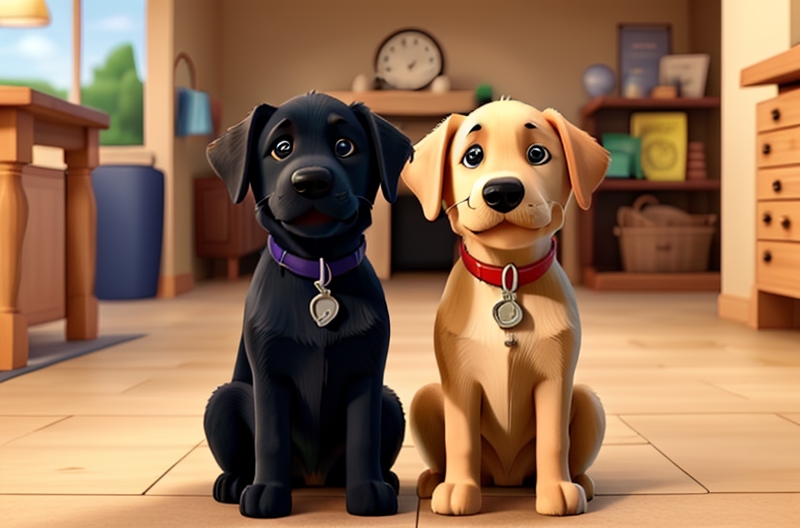In case you’re trying to find “Labrador Retrievers” Known simply as “Labs,” Labrador Retrievers are among the most well-liked dog breeds in the world. These canines, who are well-known for their intellect, adaptability, and pleasant nature, are great companions for both individuals and families.
Read Also: How to Make a Pee Spot Attractive for Dogs?
Introduction to Labrador Retrievers
Labrador Retrievers are Canadian canines that were first raised as working dogs by fishermen in Newfoundland, to help retrieve games and fishing nets. Their skills developed with time, and they gained respect as devoted hunting and retrieving partners.
Physical Characteristics of Labrador Retrievers

Labrador Retrievers typically have short, dense coats that come in three primary colors: black, chocolate, and yellow. They possess a sturdy, athletic build, with males typically weighing between 65 to 80 pounds and females between 55 to 70 pounds.
Temperament and Behavior
It is well known that labradors are extroverted and gregarious animals. They are very gregarious dogs who are well-known for their loving personalities and desire to please their owners. They are good in a variety of roles, from household pets to service and therapy dogs, because to their intelligence and trainability.
Labrador Retrievers as Family Pets
These dogs excel in family environments, forming strong bonds with both adults and children. They are generally patient and gentle with kids, making them ideal companions for households with young ones. Labs also tend to get along well with other pets, making integration into multi-pet households relatively smooth.
Common Health Concerns
Like all breeds, Labrador Retrievers are prone to certain health issues, including hip dysplasia, obesity, and joint problems. Responsible breeding practices and regular veterinary check-ups can help mitigate these risks and ensure a healthy, happy pet.
Grooming Requirements
While Labrador Retrievers have relatively low-maintenance coats, regular grooming is essential to keep them looking their best. Brushing a few times a week helps minimize shedding and keeps the coat clean and healthy. Baths should be given as needed, typically every few months or as dirt accumulates.
Training Tips for Labrador Retrievers
Due to their intelligence and eagerness to please, Labs respond well to positive reinforcement training methods. Consistency, patience, and praise are key to fostering desirable behaviors and preventing common issues such as chewing and jumping.
Exercise Needs and Activities
Labrador Retrievers are energetic dogs that require regular exercise to maintain their physical and mental well-being. Daily walks, play sessions, and engaging activities such as fetch or agility training help fulfill their need for stimulation and prevent boredom.
Labrador Retrievers as Working Dogs
While many Labs enjoy a comfortable life as family pets, their working heritage is still evident in some individuals. These dogs excel in various roles, including search and rescue, therapy work, and assistance for individuals with disabilities.
Famous Labrador Retrievers
Labrador Retrievers have made their mark in pop culture, with several notable dogs achieving fame in various mediums. From television and film to literature and advertising, these charismatic canines have captured the hearts of millions worldwide.
Choosing a Labrador Retriever Puppy

When selecting a Labrador Retriever puppy, it’s essential to choose a reputable breeder who prioritizes health and temperament. Prospective owners should also spend time with the litter to assess each puppy’s personality and ensure a good match for their lifestyle.
Nutritional Needs
A balanced diet is crucial for maintaining the health and vitality of Labrador Retrievers. High-quality commercial dog food, supplemented with fresh fruits and vegetables, provides the necessary nutrients for optimal growth and development. Portion control is essential to prevent obesity, a common issue in the breed.
Traveling with Labrador Retrievers
Whether embarking on a road trip or flying to a new destination, proper preparation is key when traveling with Labrador Retrievers. From ensuring they have proper identification and vaccinations to packing essential supplies, thoughtful planning helps ensure a safe and stress-free journey for both pet and owner.
Conclusion
In the above, we discuss Labrador Retrievers. Labrador Retrievers are beloved for their friendly disposition, intelligence, and versatility. Whether serving as devoted family pets, working alongside humans in various capacities, or charming audiences on the big screen, these dogs continue to leave an indelible mark on the hearts of dog lovers worldwide.
Read Also on Quora: What is it like to own a Labrador Retriever?
Are Labrador Retrievers good with kids?
Yes, Labrador Retrievers are generally excellent with children, and known for their patience and gentle nature.
How much exercise does a Labrador need daily?
Labrador Retrievers require at least an hour of exercise each day to stay healthy and happy.
What colors are Labrador Retrievers available in?
Labrador Retrievers come in three primary colors: black, chocolate, and yellow.
How often should I groom my Labrador?
Regular grooming, including brushing and occasional baths, helps keep your Labrador’s coat healthy and clean. Aim for brushing a few times a week.
Can Labrador Retrievers be left alone for long periods?
While Labs enjoy companionship, they can typically tolerate being alone for moderate periods, especially if adequately exercised and provided with mental stimulation.

1 thought on “Labrador Retrievers: A Comprehensive Guide”